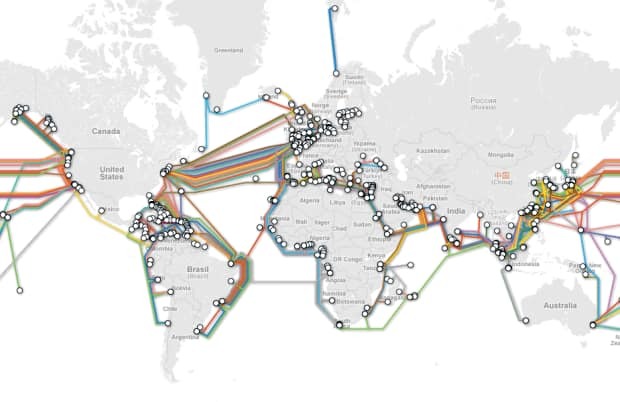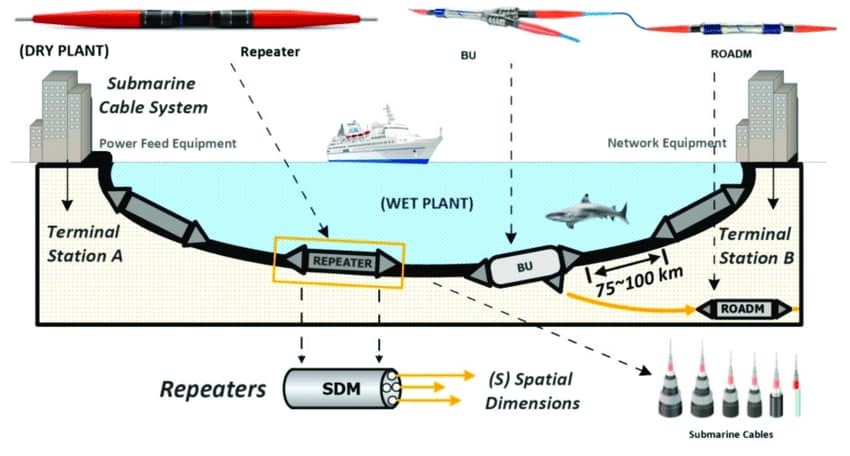How The Subsea Cable Make Internet Travels?
 Aug 01,2024
Aug 01,2024

 Suke
Suke
99 percent of all Internet traffic from YouTube to Facebook to your family WhatsApp group runs on a hidden network of subsea cable. Why do you care? Because modern life is increasingly dependent on the slinky subsea cable. However, the subsea cable often gets attacked by sharks. How does the subsea cable work? What’s the future for it? Today lets plunge into the depths and ask how the subsea cable makes Internet travel across oceans.
According to the authoritative subsea cable map website, by the end of 2022, there are currently 469 active or actively under construction sub-sea internet cables crisscrossing the globe. Moreover, a further 80 cables with a total length of approximately 390,000 kilometers are planned to be commissioned between 2023 and 2026. These range from the relatively modest 300-kilometer Azerbaijan to Turkmenistan wire running under the Black Sea. The other gargantuan 6600-kilometer MAREA cable linking Virginia Beach in the U.S. with Bilbao in northern Spain weighs the same as 24 blue whales.

But professional estimates indicate a typical transoceanic cable should cost three to four hundred million dollars which seems like a lot because they’re not especially thick typically around the girth of a garden hose. That includes layers of protective thixotropic jelly around the all-important fiber optic core plus multiple plastic sheaths and copper wiring to power the thing. But even so, on average they can ferry an awesome 100 gigabytes per second in data with newer and forthcoming cables able to transmit 400 gigabytes per second.
So how does so much data fit down such slim channels? Part of the answer is an extremely sophisticated data wrangling technique known as dense wavelength division multiplexing put simply. Dense wavelength division multiplexing lets data providers use more than one wavelength of light to convey information fiber optically. Instead, several wavelengths are employed simultaneously and stacked creating astonishing data speeds. This happens at buzzing data center-like landing sites at either end of the cable. Are the cables just straightforward long wires? Not. Quite every 70 to 100 kilometers or so along the seabed cables are punctuated with so-called repeaters. These essentially serve as amplifiers keeping the signal strength up to par over long distances. That’s why the subsea cable incorporates copper conductors by the way carrying up to 10 000 volts of DC to power the repeaters.

So who actually owns these cables? That’s an interesting question. It’s an expensive business so historically nations or quasi-national telecom providers have picked up the bill. The world’s biggest owner of cables remains America’s AT&T with a stake in some 230,000 kilometers of subsea cable. The second biggest owner is China Telecom. Frequently cables are owned by groups or consortia of up to 50 separate owners including tech firms, local government agencies, and other businesses.
And while this model helps spread the initial cost it’s less helpful. When something goes wrong and nobody can agree who has to put on a wetsuit and do something about it? Increasingly big tech is recognizing its scope for growth is limited by the subsea cable network. So over the past few years, the overwhelming majority of investment in subsea cable infrastructure has come from companies like Facebook which currently owns nearly 100,000 kilometers of cables. Google owns roughly the same amount. Amazon has its own massive private network hooking up the online giant’s mighty data centers through cables traversing the Atlantic pacific and Indian Oceans plus the Mediterranean, the Red Sea, and the South China Sea. The tech giants like to frame these vast environmentally disruptive infrastructure projects as a civilization-enhancing largesse on their part. But they’re also shareholder companies who know perfectly well that increasing the number of human beings online is the only way they can continue to grow.
For now, cable is by far the cheapest and most efficient means of eating vast packets of data over incredibly long distances fast. Even Elon Musk agrees that the future is very much the undersea cable. Will mankind’s ingenious submarine network one day look as obsolete as the telegraph? The future of the subsea cable should be created by us.

 Home
Home Why It Is Nearly Impossible For The Underground Cable To Be Repaired?
Why It Is Nearly Impossible For The Underground Cable To Be Repaired?  You May Also Like
You May Also Like

 Tel
Tel
 Email
Email
 Address
Address













